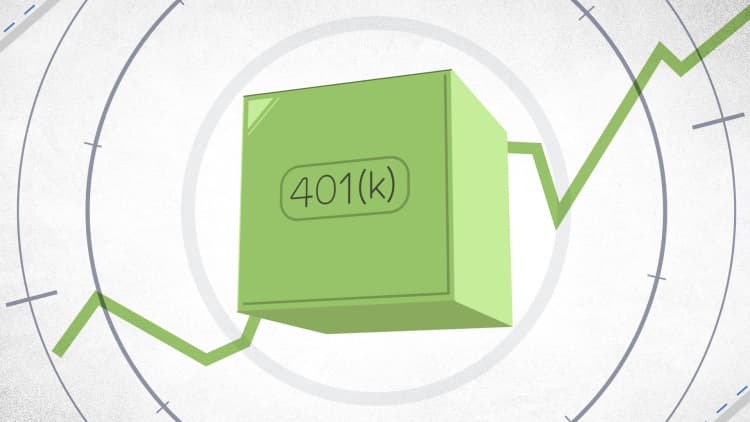Klaus Vedfelt | Getty Images
To live your best life in retirement, it helps to make the most contributions while you’re working.
Employees who participate in 401(k) plans can put up to $23,000 in pre-tax or post-tax Roth contributions in 2024.
But there’s another limit — $69,000, including employee and employer contributions — that may let workers set aside even more. If the 401(k) plan allows for it, workers may add post-tax contributions beyond the $23,000 limit for 2024 up to $69,000, provided their salary is more than that threshold.
More from Personal Finance:
More retirement savers are borrowing from their 401(k) plan
Why employers can force out small 401(k) accounts once a worker leaves a job
Job data shows two kinds of workers: the ‘haves and have nots’
That goes up to as much as $76,500 when including a $7,500 catch-up contribution for savers ages 50 and over.
“If you want to save more for retirement, the best place to do it is to start with, does your plan allow for after-tax contributions?” said David Blanchett, a certified financial planner and head of retirement research at PGIM DC Solutions.
How a Roth may help you ‘save more effectively’
To maximize your post-tax savings, you may do an annual in-plan rollover to a Roth, he said, provided your employer offers this option.
“Then if you wanted to save more effectively, you could then save your regular deferrals as Roth as well,” Blanchett said.
Having 100% Roth retirement savings could be a “smart move” for someone interested in maximizing retirement savings, he said.

For most people, traditional pre-tax contributions to retirement plans like a 401(k) make sense, because their tax rates will likely decline once they retire, Blanchett said.
However, Roth investments allow for the potential opportunity for savings by paying taxes at current rather than future rates, which tend to increase, he said.
That helps make Roth savings more valuable. When deferring 6% to traditional pre-tax retirement savings or 6% to as post-tax Roth money, the Roth is actually worth 7% or 8%, Blanchett said.
Few investors max out their 401(k) contributions
To be sure, just reaching the $23,000 maximum 401(k) contribution — or $30,500 with the $7,500 catch-up contributions for those ages 50 and over — is a feat for most workers.
In 2022, 15% of retirement plan participants saved the highest amount of $20,500 for that year, or $27,000 for those ages 50 and up, according to Vanguard research.
Participants who successfully met those maximum thresholds tended to have high incomes, have longer tenures with their employers, be older in age and already have higher balances, according to Tiana Patillo, a certified financial planner and financial advisor manager at Vanguard.
Principal Financial Group, a provider of 401(k) and other retirement plans, has defined “super savers” as those who contribute at least 15% of their pay toward retirement or 90% or more of the maximum allowed.
Beyond having high incomes, this cohort tends to share certain characteristics, according to Chris Littlefield, president of retirement and income solutions at Principal.
As of November, less than 3% of participants in retirement plans serviced by Principal had maxed out their 401(k) contributions for the year.
What workers can learn from ‘super savers’
Investors who do meet those thresholds tend to be very disciplined, have clearly defined goals for their retirement plans, are optimistic and excited about the future and tend to live modestly and below their means, Littlefield said.
When inflation prompted consumer prices to climb, super saver retirement investors still prioritized increasing their retirement contributions, Principal’s research found.
“You want to be fairly disciplined and try to take the emotion out of it, not being scared or overwhelmed,” Littlefield said.
Not all retirement savers can push their contributions to the maximum thresholds allowed. But experts say there are several tips that can help to push their savings levels higher.
1. Start with small steps
“We all need to start somewhere,” Littlefield said.
By setting aside what you can now, you’re giving that money time to compound, or earn returns on both your original principal and returns.
2. Build in automatic increases
If you’re due to get a raise of 2% to 4% of your base salary from your employer this year, increase your retirement deferral rate ahead of that bump to your paycheck, Littlefield suggested.
Your retirement plan may even allow you to make it so those increases happen automatically, say with a 1% increase to your deferral rate that sets in at the beginning of January.
3. Contribute enough to get your employer match
Many employers will match your contributions up to a certain deferral amount, such as 4% or 6%.
“You don’t want to necessarily miss out on the free money that’s in store from your employer,” Patillo said.
4. Budget wisely to preserve your retirement funds
To make room in your budget to maximize your retirement savings, cut down on any high interest debts, Patillo recommends.
Also plan to set aside money towards an emergency fund, such as $25 to $50 per paycheck, with the goal of eventually reaching three to six months’ expenses, she said.

